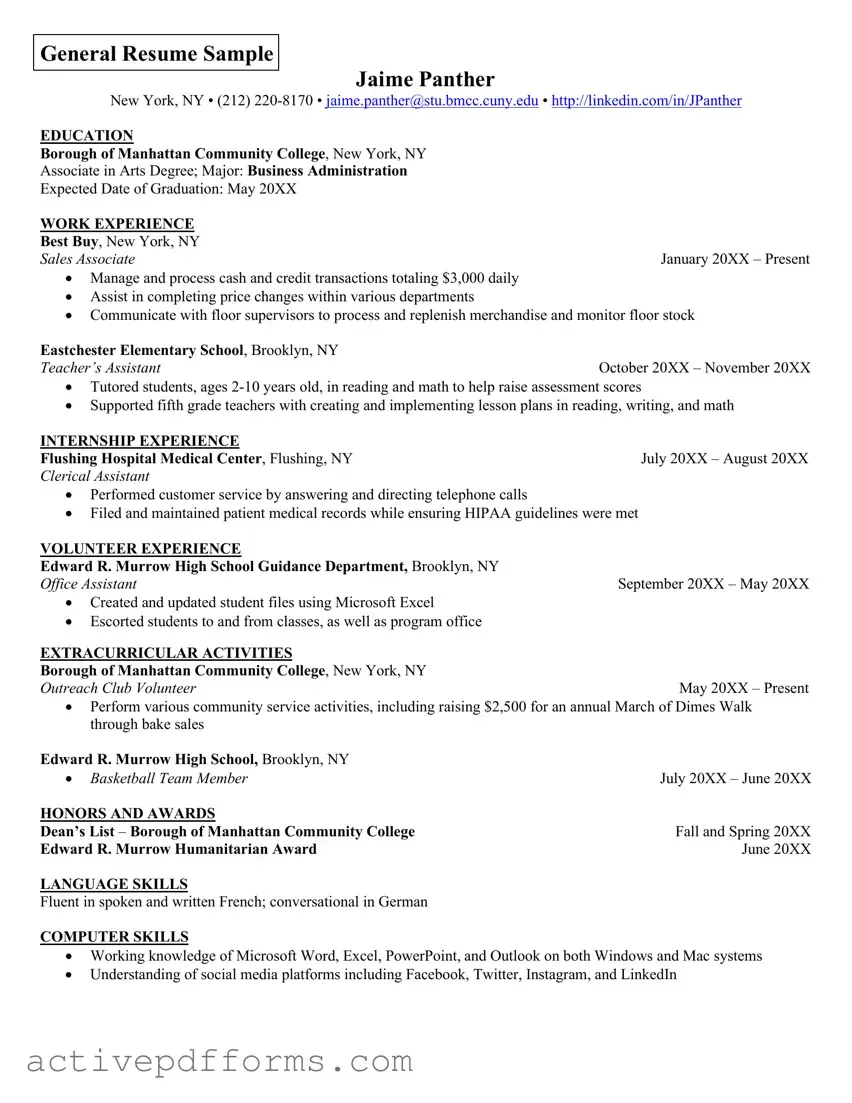General Resume Sample
Jaime Panther
New York, NY • (212) 220-8170 • jaime.panther@stu.bmcc.cuny.edu • http://linkedin.com/in/JPanther
EDUCATION
Borough of Manhattan Community College, New York, NY
Associate in Arts Degree; Major: Business Administration
Expected Date of Graduation: May 20XX
WORK EXPERIENCE |
|
Best Buy, New York, NY |
January 20XX – Present |
Sales Associate |
•Manage and process cash and credit transactions totaling $3,000 daily
•Assist in completing price changes within various departments
•Communicate with floor supervisors to process and replenish merchandise and monitor floor stock
Eastchester Elementary School, Brooklyn, NY |
October 20XX – November 20XX |
Teacher’s Assistant |
•Tutored students, ages 2-10 years old, in reading and math to help raise assessment scores
•Supported fifth grade teachers with creating and implementing lesson plans in reading, writing, and math
INTERNSHIP EXPERIENCE
Flushing Hospital Medical Center, Flushing, NYJuly 20XX – August 20XX Clerical Assistant
•Performed customer service by answering and directing telephone calls
•Filed and maintained patient medical records while ensuring HIPAA guidelines were met
VOLUNTEER EXPERIENCE |
|
Edward R. Murrow High School Guidance Department, Brooklyn, NY |
September 20XX – May 20XX |
Office Assistant |
• Created and updated student files using Microsoft Excel |
|
• Escorted students to and from classes, as well as program office |
|
EXTRACURRICULAR ACTIVITIES |
|
Borough of Manhattan Community College, New York, NY |
May 20XX – Present |
Outreach Club Volunteer |
•Perform various community service activities, including raising $2,500 for an annual March of Dimes Walk through bake sales
Edward R. Murrow High School, Brooklyn, NY |
July 20XX – June 20XX |
• Basketball Team Member |
HONORS AND AWARDS |
|
Dean’s List – Borough of Manhattan Community College |
Fall and Spring 20XX |
Edward R. Murrow Humanitarian Award |
June 20XX |
LANGUAGE SKILLS |
|
Fluent in spoken and written French; conversational in German |
|
COMPUTER SKILLS
•Working knowledge of Microsoft Word, Excel, PowerPoint, and Outlook on both Windows and Mac systems
•Understanding of social media platforms including Facebook, Twitter, Instagram, and LinkedIn
BLANK RESUME TEMPLATE |
|
|
|
Tips: |
|
|
• Experiences should be listed most recent to past |
|
|
HEADING (Do not put the word HEADING in your resume) |
• Save your resume file as “FirstName Last Name – Resume” |
this way employers know who you are |
Name _______________________________________________ |
|
|
Address ____________________________________________________________________________________________
Phone ______________________________________________________________________________________________
Professional Email (student email is okay too) ______________________________________________________________
EDUCATION
Current or most recent College/University, City, State_________________________________________________________
Degree, Major, Month and Year of Completion or Anticipated Graduation Date_____________________________________
RELATED COURSEWORK (Optional) Coursework relevant to targeted position
• |
________________________________________ |
• |
________________________________________ |
• |
________________________________________ |
• |
________________________________________ |
RESEARCH PROJECTS (Optional)
Class or personal projects completed relevant to targeted position
•______________________________________________________________________________________________
•______________________________________________________________________________________________
LICENSES/CERTIFICATIONS (Be sure to include expiration dates) (Optional)
•______________________________________________________________________________________________
WORK EXPERIENCE (“Related Experience” or “Internships”, “Clinical Rotations,” from the most recent to the oldest)
Name of Company/Organization, City, State ______________________________________________________________
Job Title_________________________________________________________Dates of Employment __________________
Brief overview of role and responsibilities, using impact action verbs, accomplishments, and achievements:
•______________________________________________________________________________________________
•______________________________________________________________________________________________
•______________________________________________________________________________________________
Name of Company/Organization, City, State ______________________________________________________________
Job Title__________________________________________________________Dates of Employment__________________
Brief overview of role and responsibilities, using impact action verbs, accomplishments, and achievements:
•______________________________________________________________________________________________
•______________________________________________________________________________________________
•______________________________________________________________________________________________
*ADDITIONAL EXPERIENCE: Use the same format as your work experience to list additional experience such as Internship, and Volunteer categories
EXTRACURRICULAR ACTIVITIES
•______________________________________________________________________________________________
•______________________________________________________________________________________________
HONORS AND AWARDS (From college, or work/internship/volunteer experience)
•______________________________________________________________________________________________
LANGUAGE SKILLS (indicate written and/or spoken proficiency, English not necessary even if it is your 2nd language)
•______________________________________________________________________________________________
COMPUTER SKILLS (indicate proficiency level [familiar with, knowledge of, proficient in, intermediate in, or beginner in])
•______________________________________________________________________________________________
•______________________________________________________________________________________________
•____________________________________________________________________________________________


